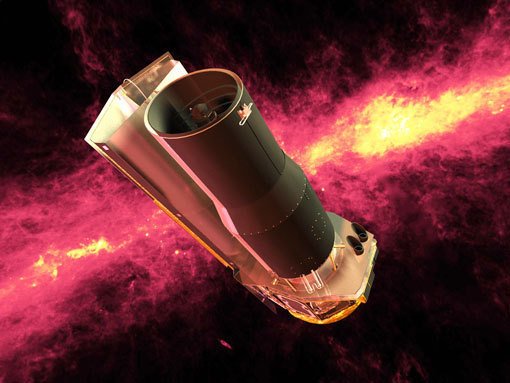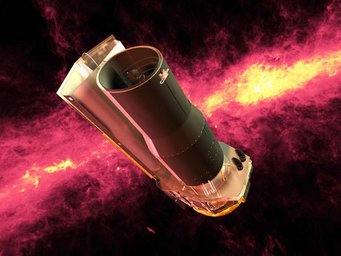New astronomical phenomenon:
Coreshine provides insight into stellar births
Science is literally in the dark when it comes to the birth of stars, which occurs deep inside clouds of gas and dust: These clouds are completely opaque to ordinary light. Now, a group of astronomers has discovered a new astronomical phenomenon that appears to be common in such clouds, and promises a new window onto the earliest phases of star formation. The phenomenon – light that is scattered by unexpectedly large grains of dust, which the discoverers have termed “coreshine” – probes the dense cores where stars are born. The results are being published in the September 24, 2010 edition of the journal Science.
| Background information | Questions & Answers | Image download |

Stars are formed as the dense core regions of cosmic clouds of gas and dust (“molecular clouds”) collapse under their own gravity. As a result, matter in these regions becomes ever denser and hotter until, finally, nuclear fusion is ignited: a star is born. This is how our own star, the Sun, came into being; the fusion processes are responsible for the Sun’s light, on which life on Earth depends. The dust grains contained in the collapsing clouds are the raw material out of which an interesting by-product of star formation is made: solar systems and Earth-like planets.
What happens during the earliest phases of this collapse is largely unknown. Enter an international team of astronomers led by Laurent Pagani (LERMA, Observatoire de Paris) and Jürgen Steinacker (Max Planck Institute for Astronomy, Heidelberg, Germany), who have discovered a new phenomenon which promises information about the crucial earliest phase of the formation of stars and planets: “coreshine”, the scattering of mid-infrared light (which is ubiquitous in our galaxy) by dust grains inside such dense clouds. The scattered light carries information about the size and density of the dust particles, about the age of the core region, the spatial distribution of the gas, the prehistory of the material that will end up in planets, and about chemical processes in the interior of the cloud.
The discovery is based on observations with NASA’s SPITZER Space Telescope. As published this February, Steinacker, Pagani and colleagues from Grenoble and Pasadena detected unexpected mid-infrared radiation from the molecular cloud L 183 in the constellation Serpens Cauda (“Head of the snake”), at a distance of 360 light-years. The radiation appeared to originate in the cloud’s dense core. Comparing their measurements with detailed simulations, the astronomers were able to show that they were dealing with light scattered by dust particles with diameters of around 1 micrometer (one millionth of a meter). The follow-up research that is now being published in Science clinched the case: The researchers examined 110 molecular clouds at distances between 300 and 1300 light-years, which had been observed with Spitzer in the course of several survey programs. The analysis showed that the L 183 radiation was more than a fluke. Instead, it revealed that coreshine is a widespread astronomical phenomenon: Roughly half of the cloud cores exhibited coreshine, mid-infrared radiation associated with scattering from dust grains in their densest regions.
The discovery of coreshine suggests a host of follow-on projects – for the SPITZER Space Telescope as well as for the James Webb Space Telescope, which is due to be launched in 2014. The first coreshine observations have yielded promising results: The unexpected presence of larger grains of dust (diameters of around a millionth of a meter) shows that these grains begin their growth even before cloud collapse commences. An observation of particular interest concerns clouds in the Southern constellation Vela, in which no coreshine is present. It is known that this region was disturbed by several stellar (supernova) explosions. Steinacker and his colleagues hypothesize that these explosions have destroyed whatever larger dust grains had been present in this region.
Background information
The results described here will be published in the September 24, 2010 edition of the journal Science , as L. Pagani, J. Steinacker et al., “The ubiquity of micron-sized dust grains in the dense interstellar medium”. The two lead authors are Laurent Pagani (Observatoire de Paris) and Jürgen Steinacker (Max Planck Institute for Astronomy, Heidelberg, and Observatoire de Paris); the other authors are Aurore Bacmann (Université Joseph Fourier – Grenoble 1 and CNRS, Laboratoire d'Astrophysique de Grenoble), Amelia Stutz (Max Planck Institute for Astronomy and University of Arizona) and Thomas Henning (Max Planck Institute for Astronomy).
During the embargo, copies of the original paper may be obtained by contacting the AAAS Office of Public Programs at 1-202-326-6440 or scipak@aaas.org
The first evidence for this phenomenon found in the molecular cloud L 183 (cf. MPIA image release 09-12) was published as J. Steinacker et al., “Direct evidence of dust growth in L183 from mid-infrared light scattering” in Astronomy & Astrophysics Vol. 511 (2010), article number A9. The researchers involved are Jürgen Steinacker (Max Planck Institute for Astronomy and Observatoire de Paris), Laurent Pagani (Observatoire de Paris), Aurore Bacmann (Observatoire de Grenoble), and Sylvain Guieu (SPITZER Science Center, Pasadena).
Questions and Answers
Why were these observations made using infrared light?
The molecular clouds in question are opaque when it comes to visible light: Viewed with ordinary telescopes, they appear as dark areas that block out the light of more distant stars. Viewed in infrared light, it is possible to look inside – the longer the wavelength, the better. With near-infrared light (in the shortest infrared wavelength range), for example, it is possible to observe stars hidden inside the molecular clouds. With far-infrared (comprising the longest infrared wavelengths) and sub-millimeter (just beyond the infrared) radiation, one can track the clouds’ thermal emissions, which allows inferences about their physical and chemical properties. The new results presented here allow for a new type of observations in the mid-infrared.
What is the role of the cloud’s dust particles?
The dust particles are the stuff Earth-like (“terrestrial”) planets are made of. Such planets are born in the course of star formation, in a disk surrounding the young star. The dust particles are coated with ice, which allows them to stick together and form increasingly larger clumps. The time-scales and details of this clumping are an important piece of the puzzle that is planet formation. The dust particles embedded in molecular clouds are typically 0.1 micrometers in diameter, and they provide important information about the cloud, absorbing, as they do, radiation at shorter wavelengths and emitting longer-wavelength (thermal) radiation. Coreshine demonstrates, for the first time, the presence of larger grains of dust (1 micrometer in diameter) in cloud cores, which shows that clumping begins before the collapse itself.
How was the discovery made?
Until now, mid-infrared light was thought to carry hardly any information about molecular clouds: The clouds themselves are too cold for their thermal radiation to feature in this wavelength range, and most clouds do not contain nearly enough matter to absorb significant amounts of the mid-infrared radiation flooding our galaxy (the galactic background radiation). That’s why, when Steinacker et al. 2009 noticed mid-infrared radiation in Spitzer observations of the molecular cloud L 183, they faced a puzzle: Complex simulations of how radiation and matter interact within such a cloud showed that this was scattered light – portions of the galactic mid-inrared background radiation that had been absorbed by cloud matter, and re-emitted in all directions. But it was physically impossible for the presumed content of the cloud – with dust grains of up to 0.1 micrometer in diameter – to scatter radiation at these wavelengths. In order to account for their observations, the researchers had to include dust particles that were ten times larger. This amounted to the discovery of a new phenomenon: the scattering of mid-infrared radiation by larger dust particles in the cores of molecular clouds.
What information can be expected from future studies of coreshine?
Coreshine opens a new window into the dense cores of molecular clouds – and promises a rich harvest of information about the earliest phases of star formation. The growth of dust particles inside clouds can be used to make deductions about density fluctuations and turbulence inside the cloud. The mechanism behind coreshine – the scattering of light – is highly sensitive to changes in the density of cloud matter. In this way, coreshine can be used to infer the three-dimensional density distribution of the gas. In addition, the growth of dust particles is a continuous process. This allows for an estimate of the denser region’s (the “cloud core’s”) age. The dust particles play a key role when it comes to cloud chemistry – chemical reactions taking place on their surfaces are an important factor when it comes to changing the cloud’s chemical composition. This is where coreshine and more traditional observations that provide information about the abundances of different species of molecules in the cloud (infrared, sub-mm, radio), complement each other.
Which telescope was used for the observations?
The results presented here are based on observations with NASA’s SPITZER Space Telescope, which was launched in 2003. The original data was collected as part of a much larger data set, several “SPITZER Legacy Surveys” over the course of several years. Even though SPITZERran out of liquid helium coolant in 2009, observations in this particular wavelength range are unaffected. The next telescope to allow for observations at these wavelengths will be the James Webb Space Telescope, a collaboration between NASA, ESA and the Canadian Space Agency, due to be launched in 2014.



Download area

- PDF RGB 11.31 MB
- JPG RGB 510 x 249 pxl 195.84 kB
- JPG RGB 1000 x 363 pxl 485.29 kB
- JPG RGB 1800 x 654 pxl 1.36 MB




Animation













